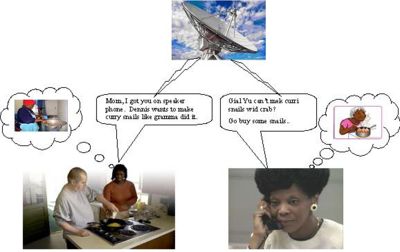Training Educators to Design and Develop ODL Materials/Principles of ODL
| Work in progress, expect frequent changes. Help and feedback is welcome. See discussion page. |
| Workshop Modules | Principles of ODL | ID Models | Needs Analysis | Developing Learners’ Profile | Methods of Delivery | Content Development Methodology for ODL | Types of Assessment in ODL | Developing a Student Guide | Relevant Technologies | Course Evaluation | Other Key Issues |
Contents
Module 1: Principles of ODL
Very often we think of ODL in the context of education that is formatted for a specific audience in this new age of technology and advance telecommunications. We invite you to consider some of the activities that we have all been a part of that we might not consider within the ODL context at this point.
Everyday activities that are examples of ODL scenarios
- A 9 year old is at home with his mother. She clutches her throat but brings no sound. The child quickly calls 911. The operator, sensing that there is no time to send an ambulance, quickly instructs the child to put the telephone on speaker and to do exactly as the operator instructs. The child is coached to administer CPR and the parent is saved.
- Sharifah is from Belize. She marries a guy from Namibia and they live in Canada. He had been to Belize and ate Curri Snails that Sharifah's grandma made the old-fashioned way. Now he wants to eat this same dish. He figures that since he does not have snails he can use crabs. Sharifah does not know how to make the snail meal and she certainly does not do it with crabs. Grandma died so Sharifah calls her mother (who is living in California) for help.
In this module the participant will able to:
|
User generated definitions of ODL
- User interpretation of Open Learning
- When you hear the term "Open Learning" What is the immediate thought that comes to your mind?
- Does the term have anything to do with openness to learning?
- Is "Open Learning" reflective of learning in the open?
- User interpretation of Distance Learning
- When you hear the term "Distance Learning" What is the immediate thought that comes to your mind?
- Does the term reflect anything relating to space and location?
- Is distance a requirement for this type of learning?
- Open and Distance Learning
- Does the term reflect merely the combination of Open Learning and Distance Learning ?
- Is there more to this than the mere combination?
- What unique quality does this combination suggest?
- Is this type of learning different from the traditional type of learning in your environment?
Scenario evaluation of ODL situations worldwide (based on the user definition and the dictionary definition)
| What is ODL?
Open and distance learning (ODL) combines two forms of education—open and distance—that focus on expanding access to learning. It is characterised by two factors: its philosophy and its use of technology. Most ODL systems have a philosophy that aims to:
In short, ODL is about increasing educational access and increasing educational choice. ODL systems typically use technology to mediate learning, for example:
|
|
ODL Uses
In this unit the participant will be able to:
|
- Formal Training
- structured arrangement that provides a systematic approach to the acquisition of credits
- needs some form of bureaucracy
- certificate, diploma and degree programme
- Informal Training
- personal development (eg: IT courses, cooking courses)
- community support (eg: developing courses in areas where the community is lacking a skill like computer literacy)
- social development
- Professional Development
- improvement of qualifications
- self-actualisation
Applicability
In this unit the participant will be able to:
|
ODL materials are applicable in
- Leveling of the âplaying groundâ
- Accessibility
- Affordability
- Continued development
- Social Stability
- Brain drain
- Cultural denigration
Face-To-Face vs ODL
In this unit the participants will be able to:
|
| Face-To-Face | ODL |
|
Better?
|
Better?
|
|
Location
|
Location
|
|
Facilitator/Teacher
|
Facilitator/Teacher
|
|
Setting
|
Setting
|
Presentation
- Principles of ODL Presentation
 (Note: This presentation is in Open Office Impress format.)
(Note: This presentation is in Open Office Impress format.)


